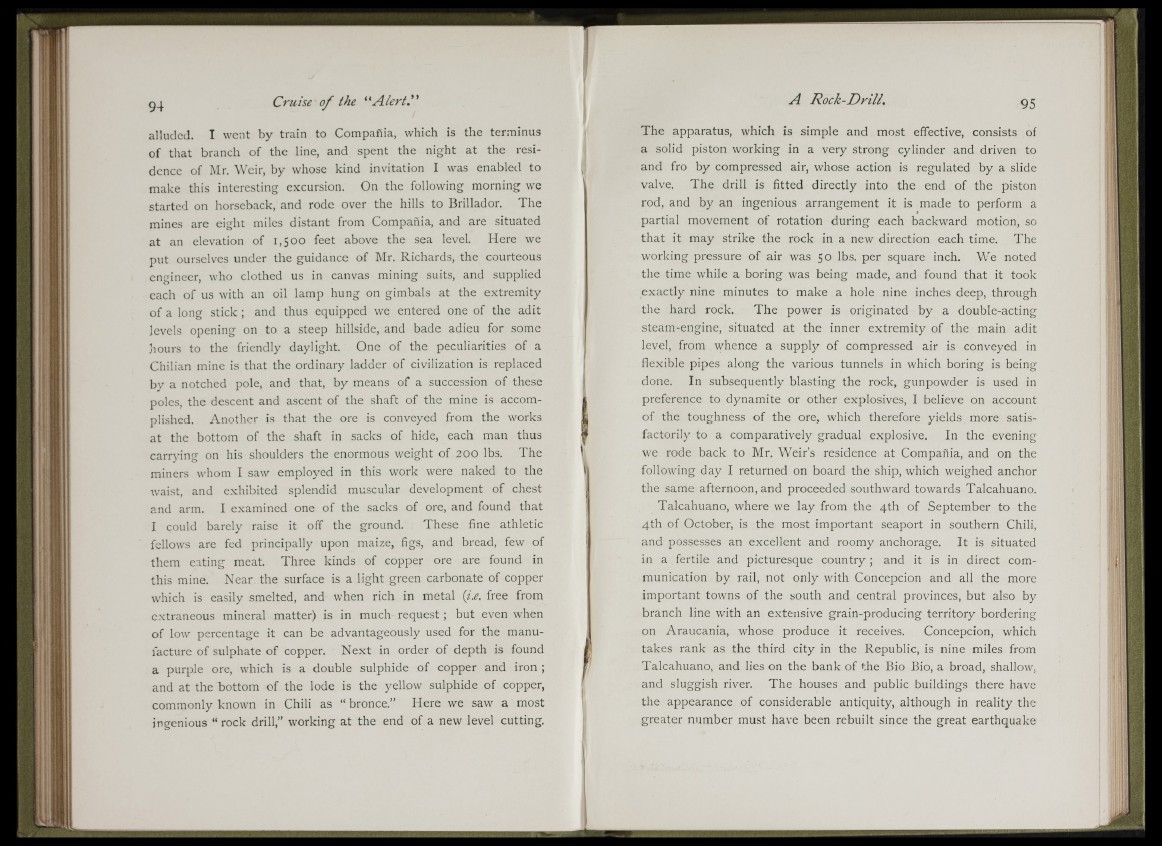
ij
i!'
i l l
alluded. I went by train to Compania, which is the ter.minus
of that branch of the line, and spent the night at the residence
of Mr. Weir, by whose kind invitation I was enabled to
make this interesting excursion. On the following morning we
started on horseback, and rode over the hills to Brillador. The
mines are eight miles distant from Compania, and are situated
at an elevation of 1,500 feet above the sea level. Here we
put ourselves under the guidance of Mr. Richards, the courteous
engineer, who clothed us in canvas mining suits, and supplied
each of us with an oil lamp hung on gimbals at the extremity
of a long stick ; and thus equipped we entered one of the adit
levels opening on to a steep hillside, and bade adieu for some
Jiours to the friendly daylight. One of the peculiarities of a
Chilian mine is that the ordinary ladder of civilization is replaced
by a notched pole, and that, by means of a succession of these
poles, the descent and ascent of the shaft of the mine is accomplished.
Another is that the ore is conveyed from the works
at the bottom of the shaft in sacks of hide, each man thus
carrvintr on his shoulders the enormous J o weight of 200 lbs. The
miners whom I saw employed in this work were naked to the
waist, and exhibited splendid muscular development of chest
and arm. I examined one of the sacks of ore, and found that
I could barely raise it off the ground. These fine athletic
fellows are fed principally upon maize, figs, and bread, few of
them eating meat. Three kinds of copper ore are found in
this mine. Near the surface is a light green carbonate of copper
which is easily smelted, and when rich in metal [i.e. free from
extraneous mineral matter) is in much request; but even when
of low percentage it can be advantageously used for the manufacture
of sulphate of copper. Next in order of depth is found
a purple ore, which is a double sulphide of copper and iron ;
and at the bottom of the lode is the yellow sulphide of copper,
commonly known in Chili as “ bronce.” Here we saw a most
ingenious “ rock drill,” working at the end of a new level cutting.
The apparatus, which is simple and most effective, consists of
a solid piston working in a very strong cylinder and driven to
and fro by compressed air, whose action is regulated by a slide
valve. The drill is fitted directly into the end of the piston
rod, and by an ingenious arrangement it is made to perform a
r
partial movement of rotation during each backward motion, so
that it may strike the rock in a new direction each time. The
working pressure of air was 50 lbs. per square inch. We noted
the time while a boring was being made, and found that it took
exactly nine minutes to make a hole nine inches deep, through
the hard rock. The power is originated by a double-acting
steam-engine, situated at the inner extremity of the main adit
level, from whence a supply of compressed air is conveyed in
flexible pipes along the various tunnels in which boring is being
done. In subsequently blasting the rock, gunpowder is used in
preference to dynamite or other explosives, I believe on account
of the toughness of the ore, which therefore yields more satisfactorily
to a comparatively gradual explosive. In the evening
we rode back to Mr. Weir’s residence at Compania, and on the
following day I returned on board the ship, which weighed anchor
the same afternoon, and proceeded southward towards Talcahuano.
Talcahuano, where we lay from the 4th of September to the
4th of October, is the most important seaport in southern Chili,
and possesses an excellent and roomy anchorage. It is situated
in a fertile and picturesque country; and it is in direct communication
by rail, not only with Concepcion and all the more
important towns of the south and central provinces, but also by
branch line with an extensive grain-producing territory bordering
on Araucania, whose produce it receives. Concepcion, which
takes rank as the third city in the Republic, is nine miles from
Talcahuano, and lies on the bank of the Bio Bio, a broad, shallow,
and sluggish river. The houses and public buildings there have
the appearance of considerable antiquity, although in reality the
greater number must have been rebuilt since the great earthquake
Ssain'
*